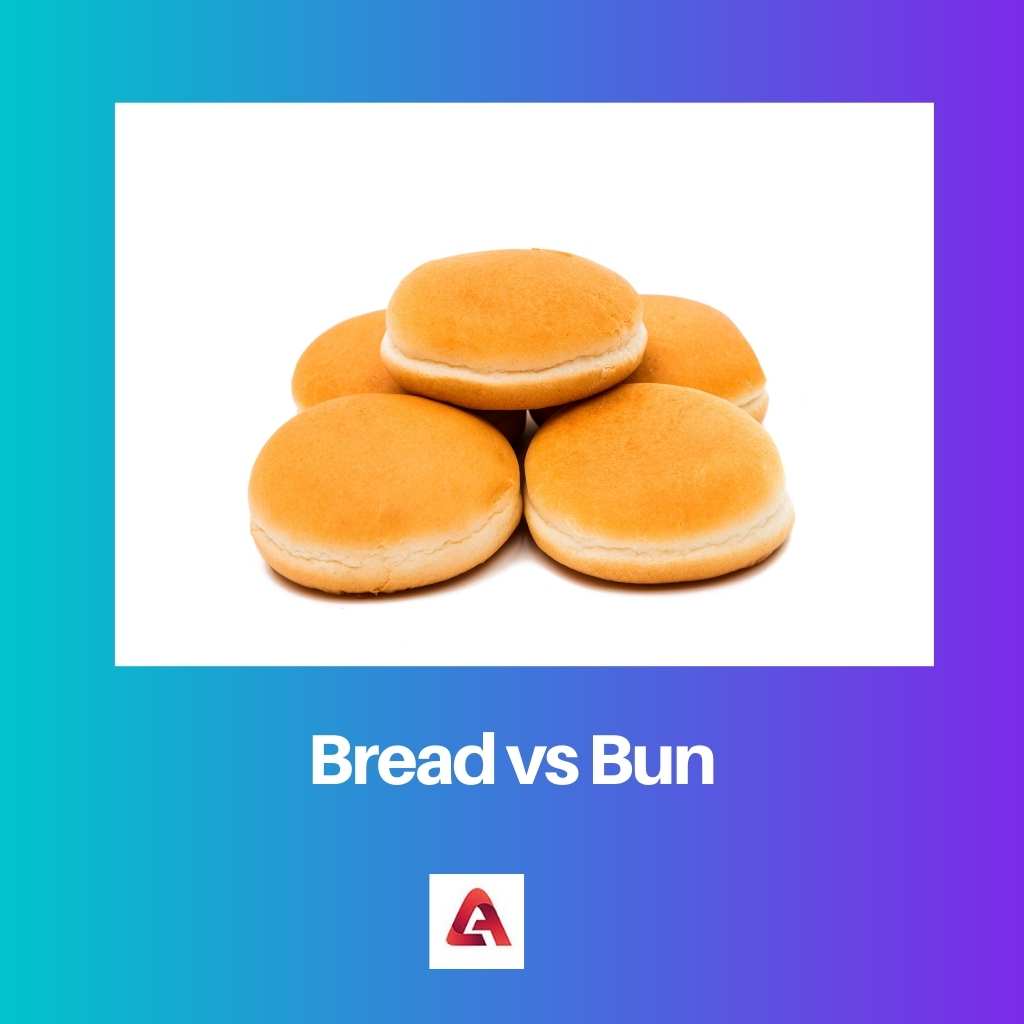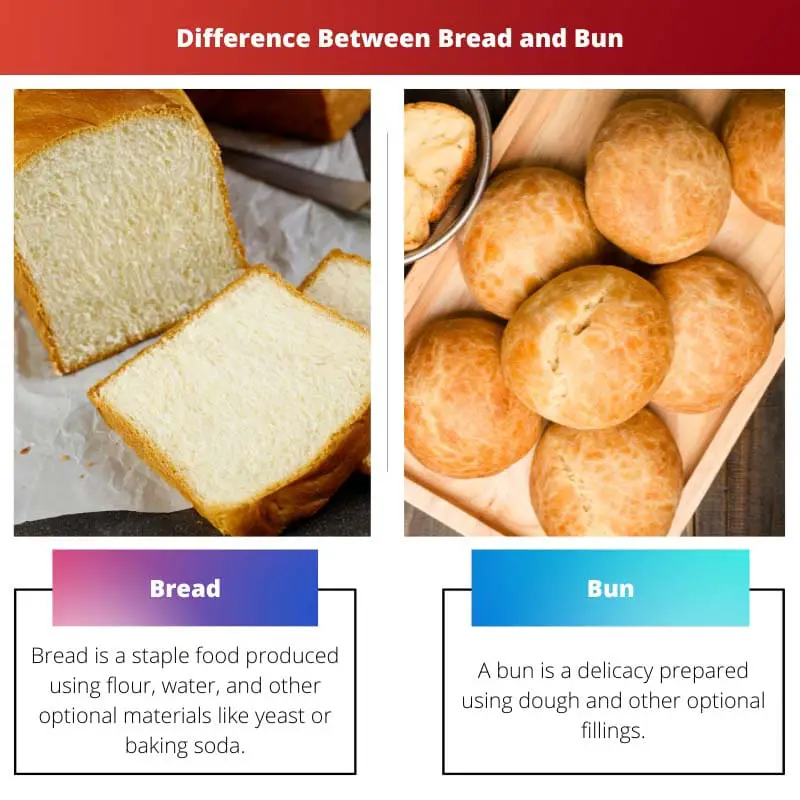Staple food is defined as a food product that is consumed by a significant number of the population. Also, staple foods are inexpensive and are rich in micronutrients as well as macronutrients which is the reason for their popularity.
Some kinds of staple food are bread, cereals, beans, legumes, etc.
Key Takeaways
- Bread is a type of baked food made from flour, water, and yeast, while buns are smaller and sweeter baked goods made with similar ingredients.
- Buns are used for sandwiches or as a side dish, while the bread is eaten as a staple.
- While bread and buns can be made in various shapes and sizes, they have distinct textures and uses.
Bread vs Bun
The difference between Bread and Bun is that Bread comes in various sizes and different tastes. On the other hand, Bun comes in round size and has a sweet taste. Moreover, Bread is baked in loaves and can have multiple servings whereas Bun is a single-serving dish.

Bread is a staple food produced using flour, water, and other optional materials like yeast or baking soda. Different regions and communities use different recipes to prepare their Bread, and that is the reason why Bread has more than 150 varieties from all over the world that are equally delicious.
A bun is a delicacy prepared using dough and other optional fillings. It is a misconception that Buns are sweet, but actually, the taste depends upon the creativity of the baker and it can have varieties.
Also, Buns have a flat bottom with a dome-shaped top that can fit in a hand.
Comparison Table
| Parameters of Comparison | Bread | Bun |
|---|---|---|
| Shape | Various shapes like flatbread, baguettes, etc. | Round, dome-like shape |
| Serving type | Can have multiple servings | Single-serving dish |
| Baking technique used | Usually, Bread is baked in loaves | Buns are baked separately |
| Usual taste | Depends on the type of Bread | Sweet |
| Legal Weight | ½ pound or 277 g in the US | Less than ½ pound in the US |
| Types | Cake, Toast, White Bread, Brown Bread, etc. | Cinnamon Bun, Bath Bun, Hamburger Bun, etc. |
| First made | Around 12,000 years ago | 18th-century |
| Invented by | The Egyptians | William Oliver |
What is Bread?
Bread is produced using flour, water, yeast, salt, and other materials. These ingredients are mixed and the dough is prepared which is baked to create Bread.
The substances used in bread-making are cheap and the preparation is inexpensive, therefore, a huge portion of the population consumes Bread making it a staple food.
The evidence suggests that the first Bread was made by The Egyptians around 12,000 years ago. Like other great inventions, the invention of Bread was an accident too.
The Egyptians found out that allowing the dough to ferment made it light and expanded it, and since then they started using the method. Egyptians also invented baking ovens to easily and efficiently produce their Bread.
Since more than 12,000 years have passed since the invention of Bread, it has traveled around the world. In present days, there are about 194 types of Bread prepared all over the world.
Some of the common types are the French Baguette, the Italian Breadstick, Whole Wheat Bread, and Paratha (originated in the Indian Subcontinent).
Part of the reason why Bread is a staple food is because it is rich in all the necessary nutrients like Iron, Calcium, Fat, and carbohydrates. Also, Bread doesn’t contain cholesterol.

| # | Preview | Product | |
|---|---|---|---|
| 1 |

| Nature's Own Butterbread, Sliced White Bread, 20 oz Loaf | Check Price on Amazon |
| 2 |

| Nature's Own Honey Wheat, Honey Wheat Sandwich Bread, 20 oz Loaf | Check Price on Amazon |
What is Bun?
Buns are common around the world as sweet and dome-shaped Bread. But, Buns can be made in different shapes and also have different fillings with multiple tastes.
The ingredients used in Bun-making are the same as that of Bread-making, i.e. water, flour, yeast, and salt. Also, Buns can use additional ingredients like cinnamon or sugar to produce a different taste.
The first Bun was made by a physician called William Oliver in the 18th century. He invented these round bread for his patients who had rheumatic diseases or arthritis.
People with arthritis are suggested not to take saturated fats and cholesterol as they harm the patient’s health. Keeping this in mind, Oliver created the first Bun to meet his patients’ needs.
Buns have a total fat of 2g out of which only 0.5g is saturated fat. Also, Buns are rich in carbohydrates, sodium, protein, and calcium. Note that here the serving size was taken 65.21g which is the average weight of a Bun.
The different types of Buns available are the Chinese Baozi, Bath Bun, Bread Roll, Cinnamon Bun, Hamburger Bun, and many others. The bun is also known as “petit pain” in French and “broetchen” in German.

Main Differences Between Bread And Bun
- Bread comes in multiple shapes like flatbread and stick-shaped Breadstick whereas Buns are round and small.
- Bread can be served to multiple people (or multiple servings to the same person) whereas Buns are a single-serving dish.
- Bread is baked in groups or loaves whereas Buns are baked separately.
- The taste of Bread depends upon the type of bread you’re eating but Buns are sweet.
- The legal weight of Bread in the US is ½ pound or 277g whereas the legal weight of a Bun in the US is less than 277g.
- Types of Bread are Banana Bread and Ciabatta Bread whereas types of Bun are Bath Bun and Hamburger Bun.
- The bread was first made around 12,000 years ago whereas Bun was first made in the 18th century.
- The bread was invented by the Egyptians whereas Bun was invented by William Oliver.

- https://www.sciencedirect.com/science/article/pii/S0260877407005869
- https://link.springer.com/article/10.1007/BF02635917


